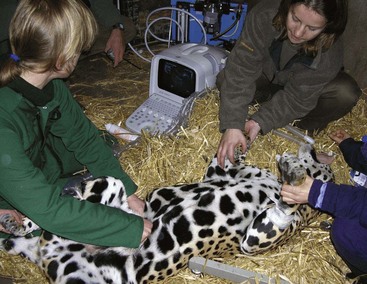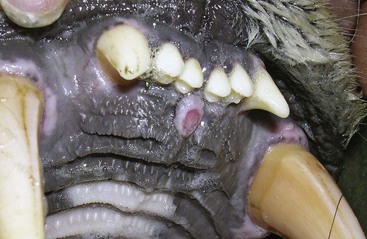Chapter 60 Aging in Large Felids
Aging
Phenotypic changes may be seen with aging—for example in pelage, skin, or body condition. Internal physiologic changes will be less obvious. In free-ranging animals, these alterations frequently result in the individual succumbing to disease, predation, or starvation. Captive animals are protected from these, but as our captive population of large felids ages, we see more degenerative age-related alterations. One study on morbidity in jaguars has shown an increase in both incidence and variability of disease processes with aging.11
Health Care in Captive Aging Felids
Older animals are predisposed to many health problems, and close monitoring of their physical and mental condition is advised. Physical signs of illness may be specific, but vague signs such as reduced appetite or weight loss should not be ignored. For several conditions, such as dental disease, osteoarthritis, and chronic renal failure, early detection and treatment will significantly improve (and may prolong) quality of life for the animal.26
Guidelines have been published by the American Animal Hospital Association for senior domestic cats, and the general principles may be well applied to large felids.2 Routine physical examinations should form part of preventive medicine protocols for geriatric patients. These may permit samples to be collected and noninvasive imaging techniques to be performed (Fig. 60-1). This baseline profile of the individual’s health will identify problems and be useful when assessing pharmacologic safety.
Anesthesia is not without risk in any age of animal, but aged individuals are more likely to have underlying chronic disease or degenerative organ dysfunction that may increase the risk. Before administering anesthesia, consideration should be given to some factors, including health status, attitude, and body weight, that may affect how the individual will cope with the drugs and procedure (Table 60-1). Ideally, animals should be trained for conscious phlebotomy so that blood parameters may be assessed before anesthesia. Blood pressure should be monitored directly or indirectly during anesthesia, and deviations (usually hypotension) should be corrected with appropriate fluid administration.
TABLE 60-1 Effects of Anesthetic Agents on Aged Felids
| Drug or Combination | Comments |
|---|---|
| Atipamezole | Stimulates the central nervous system, so should be used cautiously in neurologic patients |
| Ketamine-midazolam | Good choice for debilitated animals, with wide safety margin; cardioprotective |
| Ketamine-midazolam-butorphanol | Recommended for debilitated or geriatric large felids |
| Medetomidine | Caution with preexisting cardiac conditions. |
| Medetomidine-butorphanol-midazolam | Fully reversible; useful for animals with renal or hepatic disease |
| Phenothiazines (e.g., acepromazine) | Depress physiologic functions (e.g., blood pressure and cardiovascular responses); should be avoided in animals with preexisting cardiovascular compromise |
| Propofol | May be useful alternative to isoflurane or ketamine for animals with renal or hepatic disease |
| Tiletamine-zolazepam | High safety margin and few cardiopulmonary side effects; not advised for tigers |
Modified from Gunkel C, Lafortune M: Felids. In West G, Heard D, Caulkett N (eds): Zoo animal and wildlife immobilisation and anesthesia. Ames, Iowa, 2007, Blackwell, pp 443-457; and Lewis JCM: Veterinary considerations. Management guidelines for exotic cats. Bristol, England, 1991, Association of British Wild Animal Keepers, pp 118-145.
Common Diseases
Renal System and Urinary Tract Disease
Chronic renal disease is commonly reported as a significant reason for morbidity and mortality in nondomestic geriatric cats. Causes of chronic renal failure (CRF) frequently include chronic pyelonephritis, glomerulosclerosis, or amyloidosis. Clinical signs include polyuria or polydipsia, reduced appetite, poor coat condition, salivation, oral ulceration (Fig. 60-2), weight loss, and vomiting. Wack27 has outlined the diagnosis of CRF in detail; the mainstays of clinical pathology are blood and urine analysis. Renal changes are usually irreversible, with an extremely poor long-term prognosis.16 Treatment is targeted to slow progression and alleviate clinical signs, and should combat the primary cause and common complications (Table 60-2).
Table 60-2 Common Complications in Chronic Renal Failure1,25
| Complication | Treatment |
|---|---|
| Anemia | Iron supplementation, erythropoietin and antacids (against gastric ulceration) |
| Bacterial urinary tract infection | Antibiotic therapy based on culture and sensitivity testing |
| Dehydration | Fluid therapy |
| Hyperphosphatemia | Correction of dehydration, low phosphate diets, and/or oral phosphate binders |
| Hypokalemia | Renal diets* and potassium supplementation |
| Metabolic acidosis | Correction of dehydration, renal diets, and in severe cases bicarbonate therapy |
| Nausea and vomiting | Antacids, with H2 blockers such as famotidine |
| Proteinuria | Angiotensin-converting enzyme (ACE) inhibitor therapy, such as benazepril |
| Systemic hypertension | Amlodipine and/or benazepril |
* Large felids will not consume 100% commercial renal diet, but addition of such food as part of the diet is beneficial.
Stay updated, free articles. Join our Telegram channel

Full access? Get Clinical Tree




